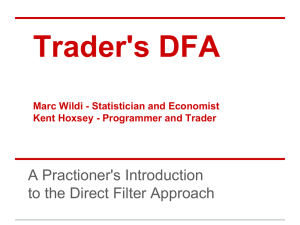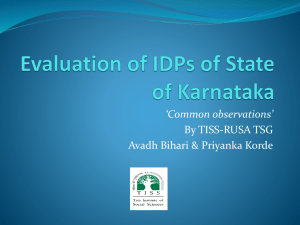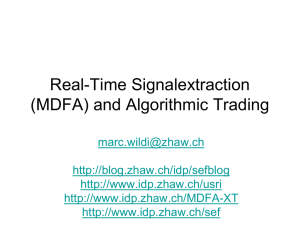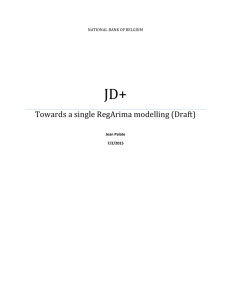Real Time Trend Extraction and Seasonal Adjustment
advertisement
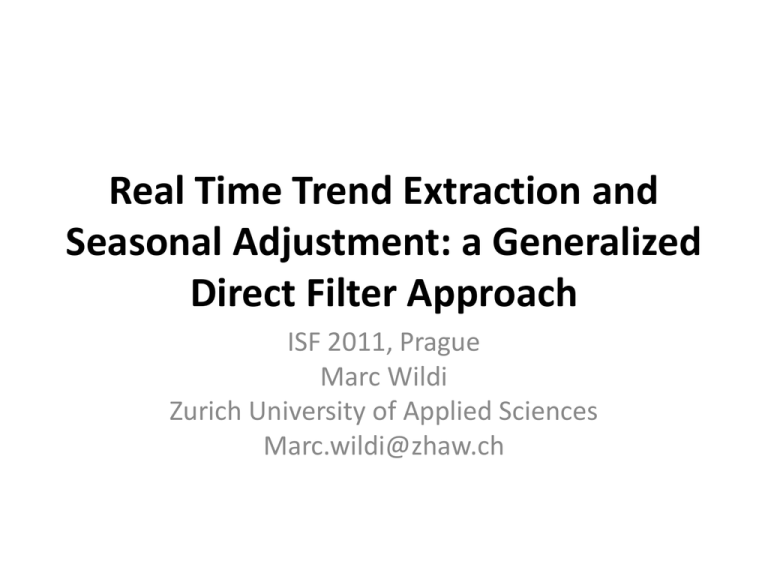
Real Time Trend Extraction and Seasonal Adjustment: a Generalized Direct Filter Approach ISF 2011, Prague Marc Wildi Zurich University of Applied Sciences Marc.wildi@zhaw.ch Signalextraction vs. Forecasting Signal X t N oisy D ata Filter: a set of w eights k such that Yt k X tk k is `fr ee of noise' Yt is the S igna l T rend, S easonally A djusted C om ponent, C yc l e Filters: k • Ad hoc designs: no explicit modelling of the data – HP-Filter, CF-Filter, BK-Filter, Henderson Filter, … • Model-based designs – TRAMO/SEATS, X-12-ARIMA, Stamp • Non-parametric filters (Loess) • Very general setting! Real-Time Signalextraction Time Domain YT k X T k `senses' the future (X T 1 , X T 2 , ...) k R eal-T im e Finite S am ple YˆT T 1 ˆ k X T k k 0 M odel-B a sed A pproaches (M B A ): k Xˆ T k k T T 1 1 k X T k k 0 T 1 k 0 X T k k Xˆ T k k 1 k k Xˆ T k k O ne- a nd m ulti-s tep ahead fore casts Example A R (1) P ro cess : X t a X t 1 t T 1 F ilter: sym . ex p o n en tial w eig h tin g Yt c |k | X tk k ( T 1) T 1 YˆT c 1 |k | k 0 X T k c Xˆ T k |k | a |k | XT k ( T 1) T 1 c |k | 1 |k | k 0 |k | k ( T 1) T 1 c X T k c X T k k 1 0 |k | c ( a ) X T k ( T 1) T 1 c k 1 |k | X T k c 1 a XT V ery cu m b erso m e w ay to d efin e a o n e-sid e d filt er! Forecasting YT k X T k k 1 1, Forecasting: k 0 for k -1 T his is a very particular (asym m etric) `S ignal' D efinition M odel-B ased O ne-step ahead Forecast! Frequency Domain Real-Time Signalextraction Frequency Domain T arget: YT k X T k k R eal-T im e E stim ate: YˆT T 1 ˆ k X T k k 0 T ransferfunctions ( ):= k exp( ik ) ( if sym m etric) k T 1 ˆ ( ):= ˆ k exp( ik ) k 0 Example: European IPI TRAMO/SEATS (Airline-Model in red) Forecasting ( ):= k exp( ik ) k 1 1, Forecasting: k 0 for k -1 ( ) 1 * exp( i ) ( ) is a very particular (allpass) Filter/T ransferfunction R eplicates T raditional M odel-B ased O ne-s tep ahead Forecast in F-D ! Optimization Criterion: Mean-Square Filter error: rt Yt Yˆt C riterion: E[ rt ] m in FILT E R W E IG H T S 2 2 | ( ) ˆ ( ) | d S ( ) m in FILT E R W E IG H T S R eal-W orld: k 2 ˆ ) m in ( k ) ˆ ( k ) S( k ˆ Choice of Spectral Estimate Sˆ ( ) • Model-based: – TRAMO (airline-model), X-12-ARIMA, state-space • Ad-hoc: – implicit model (HP, CF, BK, Henderson,…) • Non Parametric – Periodogram • This choice is to some extent arbitrary: it depends on the preference/experience/expertise of the user. • Very general setting! Generalized DFA: Very General Setting! • Arbitrary signals – Including as a special case traditional one-step ahead forecasting • Arbitrary finite sample Spectral Estimate – ad hoc, model-based, non-parametric • Generalizes – – – – Ad hoc filters Model-based filters DFA (based on the periodogram) Traditional (one-step ahead) ARIMA-modelling, statespace modelling – Extends to multivariate filtering! Frequency-Domain: Timeliness-Reliability Dilemma Control of Timeliness/Speed: 2 Cosine Law applied to ( ) ˆ ( ) ˆ ( ) ( ) ˆ ( ) ˆ ( ) ( ) ˆ ( ) ( ) ˆ ( ) 2 2 ( ) 2 ( ) ˆ ( ) 1 cos( ˆ ( )) Timeliness-Criterion T /2 2 ( k ) ˆ ( k ) Sˆ ( k ) k 1 T /2 2 A ( k ) Aˆ ( k ) Sˆ ( k ) k 1 T /2 2A ( k )Aˆ ( k ) 1 cos( ˆ ( k )) Sˆ ( k ) k 1 M ean-S quare: 1 Faster Filter : > 1 S low er Filter: < 1 Emphasize Noise Rejection in Stop Band (Reliability/Smoothness) T /2 2 A ( k ) Aˆ ( k ) W ( k )Sˆ ( k ) k 1 T /2 2A ( k )Aˆ ( k ) 1 cos( ˆ ( k )) Sˆ ( k ) k 1 W ( k ) assigns m ore w eight to am plitude in stop band assigns m ore w eigh t to tim e-shift in pas s band Essence of Generalized DFA • The new optimization criterion IS the timelinessreliability-dilemma and conversely • `Philosophy’ may be contrasted with – Maximum likelihood (particular parametric setting lambda/expweight) – Maximum entropy • Contrast: – Manipulate Real-Time filter characteristics explicitly on the edge of the fundamental dilemma – User relevant priorities (risk-aversion) Effect of `Expweight’ Effect of Lambda Example : European IPI Replicate TRAMO RT-Performance: TRAMO (red) vs. Gen. DFA (blue) New Target: Customized Design • Instead of optimal mean-square estimate the user could specify a `faster’ and/or `smoother’ real-time estimate • The new estimate is still purely model-based! – It IS TRAMO (it could be X-12, Stamp,…) – But it becomes faster/smoother (timelinessreliability dilemma) Mean-Square vs. Enhanced TRAMO • Typically, TRAMO-filter (blue) is noisy (poor noise suppression in stop-band) • The `customized’ filter (green) barely loses in terms of time-shift in the pass-band. It clearly wins in terms of noise suppression in the stop-band: better compromise TRAMO (red) vs. Enhanced (green) Conclusion • As expected, the `customized’ real-time filter (green) is as `fast’ as the MS-filter by TRAMO (red) and it is much smoother (better noise suppression) SA vs. Customized RT-Trend • Real-time customized trend filter is as fast as traditional SA-filter and much (much) smoother. Conclusion Philosophy Generalized DFA The new criterion IS the timeliness-reliability dilemma Consequences • Generalizes classical filter approaches (ad hoc, model-based) • Emphasizes user relevant priorities explicitly Practicality • Numerically (very) fast – Closed-from approximation (I-DFA/open source) – Fast exact optimization (Eurostat/proprietary) • Short piece of (R-) code – Could easily dock to any existent software/tool Web: • • • • SEFblog: http://blog.zhaw.ch/idp/sefblog USRI: http://www.idp.zhaw.ch/usri MDFA-XT: http://www.idp.zhaw.ch/MDFA-XT SEF-page: http://www.idp.zhaw.ch/sef Selected SEFBlog-Entries • Forecasting the EURO-BUND-Future (6 months, one Year) – http://blog.zhaw.ch/idp/sefblog/index.php?/archives/ 186-Forecasting-the-EURO-Bund-Future-6-monthsand-One-Year-Ahead-FirstPreliminary-Draft.html • OECD-CLI: leading indicator for the US – http://blog.zhaw.ch/idp/sefblog/index.php?/archives/ 173-Tutorial-I-MDFA-Part-II-The-OECD-CLI-for-theUS.html – http://blog.zhaw.ch/idp/sefblog/index.php?/archives/ 175-Injecting-the-ZPC-Gene-into-I-MDFA-anApplication-to-the-OECD-CLI-for-the-US.html SEFBlog-Entries • Algorithmic Trading: – http://blog.zhaw.ch/idp/sefblog/index.php?/archives/ 157-A-Generalization-of-the-GARCH-in-Mean-ModelVola-in-I-MDFA-filter.html • Tutorials Univariate Filter: – http://blog.zhaw.ch/idp/sefblog/index.php?/archives/ 159-I-DFA-Exercises-Part-I-Mean-SquareCriterion.html – http://blog.zhaw.ch/idp/sefblog/index.php?/archives/ 160-I-DFA-Exercises-Part-II-CustomizationSpeedReliability.html SEFBlog-Entries • Tutorials Multivariate Filter: – http://blog.zhaw.ch/idp/sefblog/index.php?/archi ves/172-Tutorial-I-MDFA-Part-I-Simulated-TimeSeries.html – http://blog.zhaw.ch/idp/sefblog/index.php?/archi ves/173-Tutorial-I-MDFA-Part-II-The-OECD-CLI-forthe-US.html
